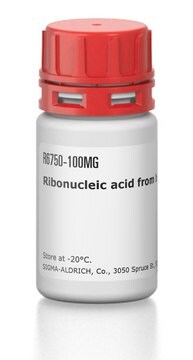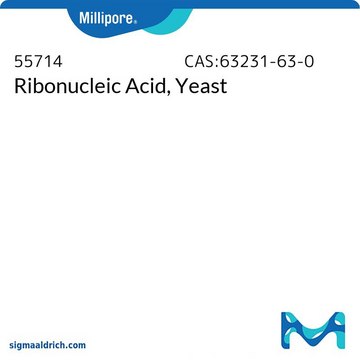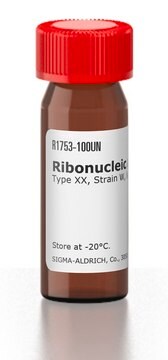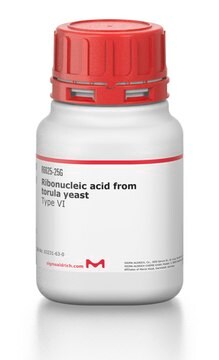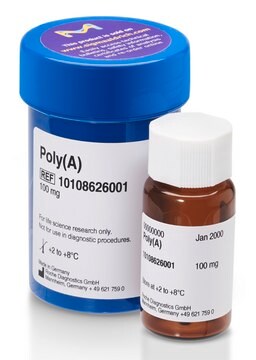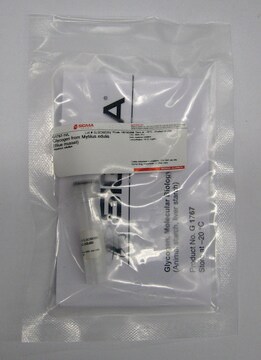R5636
Ribonucleic acid, transfer from baker′s yeast (S. cerevisiae)
buffered aqueous solution
Synonym(s):
Transfer RNA, tRNA
Sign Into View Organizational & Contract Pricing
All Photos(1)
About This Item
Recommended Products
grade
for molecular biology
Quality Level
form
buffered aqueous solution
concentration
≥9 mg/mL
foreign activity
DNase, Nickase, none detected
shipped in
dry ice
storage temp.
−20°C
Looking for similar products? Visit Product Comparison Guide
General description
Transfer RNA (tRNA) is isolated from baker′s yeast by phenol-chloroform extraction and ethanol precipitation. tRNAs are approximately 80 nucleotides long RNA molecules with a cloverleaf shaped secondary structure and a tertiary L-shaped structure.
Application
Suitable for use as a carrier in nucleic acid purification and precipitation.
Ribonucleic acid, transfer from baker′s yeast (S. cerevisiae) has been used:
Ribonucleic acid, transfer from baker′s yeast (S. cerevisiae) has been used:
- in carrier solution as a part of control used for reverse transcriptase – quantitative polymerase reaction (RT-qPCR) assay
- as a component of prehybridization(4) and hybridization buffer in single-label in situ hybridization
- as a carrier to enhance recovery of RNA from small numbers of cells
Biochem/physiol Actions
Transfer RNAs (tRNAs) play an important role in translation. It is responsible for the addition of amino acids to ribosome for peptide chain formation. The tRNA contains an anticodon region for mRNA base pairing and two attachment regions: for amino acid binding and tRNA synthetase recognition. The ribosomal RNA facilitates the movement of tRNA along the mRNA.
Components
tRNA is provided in a solution in 10 mM Tris HCl (pH 7.4) in 1 mM EDTA.
related product
Product No.
Description
Pricing
Choose from one of the most recent versions:
Already Own This Product?
Find documentation for the products that you have recently purchased in the Document Library.
Customers Also Viewed
Quantitative Analysis of T Cell Receptor Diversity in Clinical Samples of Human Peripheral Blood
Memon SA, et al.
Journal of Immunological Methods, 375(1-2), 84?92-84?92 (2012)
Eric A Nalefski et al.
iScience, 24(9), 102996-102996 (2021-09-11)
Bacterial CRISPR systems provide acquired immunity against invading nucleic acids by activating RNA-programmable RNases and DNases. Cas13a and Cas12a enzymes bound to CRISPR RNA (crRNA) recognize specific nucleic acid targets, initiating cleavage of the targets as well as non-target (trans)
Naming 'junk': human non-protein coding RNA (ncRNA) gene nomenclature
Wright MW and Bruford EA
Human Genomics, 5(2), 90-90 (2011)
A comparison of miRNA isolation and RT-qPCR technologies and their effects on quantification accuracy and repeatability
Redshaw N, et al.
Biotechniques, 54(3), 155-164 (2013)
The distribution of neuropeptide Y gene expression in the chicken brain
Wang X, et al.
Molecular and Cellular Endocrinology, 174(1-2), 129-136 (2001)
Our team of scientists has experience in all areas of research including Life Science, Material Science, Chemical Synthesis, Chromatography, Analytical and many others.
Contact Technical Service

